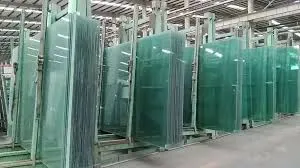Double toughened glass, often known as safety glass, is an innovative product that significantly enhances the safety and functionality of modern architecture and various product designs. This glass type, meticulously manufactured through a high-temperature tempering process, stands as a testament to contemporary advancements in materials science.

From a practical standpoint, one of the most compelling reasons to choose double toughened glass is its incredible strength. The tempering process involves heating the glass to a softening point and then rapidly cooling it, which compresses the exterior surfaces and tensions the interior.
This results in a piece of glass that is approximately four to five times stronger than regular annealed glass. As a result, it can withstand high impacts and pressure, drastically reducing the risk of breakage and ensuring enhanced safety for users.
In residential and commercial construction, double toughened glass is a popular choice for windows, doors, facades, and even furniture. Its ability to handle varying climatic conditions without succumbing to wear and tear means that buildings can benefit from improved longevity and reduced maintenance costs. Moreover, its robust nature allows it to serve as a security feature against forced entry attempts, adding an extra layer of protection against intrusions.

Apart from its strength, another significant advantage of double toughened glass is its thermal performance. The glass prevents heat from escaping, providing excellent insulation which, in turn, contributes to an energy-efficient environment. This feature is particularly beneficial in regions with extreme weather conditions, where maintaining a consistent indoor temperature is a priority. Consequently, utilizing double toughened glass can contribute to reduced energy bills, aligning with the growing demand for sustainable building practices.
For interior designers, double toughened glass offers aesthetic flexibility without compromising safety. It can seamlessly integrate into any design vision, providing clarity and openness while serving as a barrier. Whether it's used in the form of a sleek shower screen, a transparent partition, or even a stunning glass staircase, it adds a modern touch and elegance to spaces while maintaining structural integrity.
double toughened glass
In industrial applications, double toughened glass is equally indispensable. It is commonly used in the manufacture of automotive glass, laboratory equipment, and even in the creation of advanced electronic gadgets. Its ability to withstand mechanical and thermal stress without breaking allows it to meet the highest standards of safety and reliability. This is crucial not just for consumer safety, but also for maintaining the reputation of manufacturers who rely on this material for quality assurance.
Despite its numerous advantages, it is crucial that double toughened glass is installed correctly to ensure its structural performance and safety features are fully realized. Professionals dealing with this material need to possess an in-depth understanding and respect for the procedures involved in its handling and installation. When cut or drilled post-tempering, the glass can explode due to the release of internal stresses; hence, precision and expertise during installation are paramount.
When considering the environmental impact, double toughened glass is a recyclable material, making it a viable option in striving for eco-friendly building designs. Its durability means replacement is less frequent, further decreasing the environmental footprint over time. Manufacturers committed to sustainable practices can certify their products, ensuring that architects and builders have access to materials that support green building initiatives.
In conclusion, double toughened glass is not just a product of advanced technological processes, but also an essential component across various applications due to its multifaceted benefits. Combining strength and safety with insulating properties and aesthetic appeal, it meets a diverse set of needs, ensuring it remains a leading choice for those committed to quality and reliability in their projects. With continual innovations in the manufacturing processes and an increasing emphasis on sustainability, double toughened glass is poised to play an integral role in the future of safe and sustainable building practices.
 Afrikaans
Afrikaans  Albanian
Albanian  Amharic
Amharic  Arabic
Arabic  Armenian
Armenian  Azerbaijani
Azerbaijani  Basque
Basque  Belarusian
Belarusian  Bengali
Bengali  Bosnian
Bosnian  Bulgarian
Bulgarian  Catalan
Catalan  Cebuano
Cebuano  Corsican
Corsican  Croatian
Croatian  Czech
Czech  Danish
Danish  Dutch
Dutch  English
English  Esperanto
Esperanto  Estonian
Estonian  Finnish
Finnish  French
French  Frisian
Frisian  Galician
Galician  Georgian
Georgian  German
German  Greek
Greek  Gujarati
Gujarati  Haitian Creole
Haitian Creole  hausa
hausa  hawaiian
hawaiian  Hebrew
Hebrew  Hindi
Hindi  Miao
Miao  Hungarian
Hungarian  Icelandic
Icelandic  igbo
igbo  Indonesian
Indonesian  irish
irish  Italian
Italian  Japanese
Japanese  Javanese
Javanese  Kannada
Kannada  kazakh
kazakh  Khmer
Khmer  Rwandese
Rwandese  Korean
Korean  Kurdish
Kurdish  Kyrgyz
Kyrgyz  Lao
Lao  Latin
Latin  Latvian
Latvian  Lithuanian
Lithuanian  Luxembourgish
Luxembourgish  Macedonian
Macedonian  Malgashi
Malgashi  Malay
Malay  Malayalam
Malayalam  Maltese
Maltese  Maori
Maori  Marathi
Marathi  Mongolian
Mongolian  Myanmar
Myanmar  Nepali
Nepali  Norwegian
Norwegian  Norwegian
Norwegian  Occitan
Occitan  Pashto
Pashto  Persian
Persian  Polish
Polish  Portuguese
Portuguese  Punjabi
Punjabi  Romanian
Romanian  Russian
Russian  Samoan
Samoan  Scottish Gaelic
Scottish Gaelic  Serbian
Serbian  Sesotho
Sesotho  Shona
Shona  Sindhi
Sindhi  Sinhala
Sinhala  Slovak
Slovak  Slovenian
Slovenian  Somali
Somali  Spanish
Spanish  Sundanese
Sundanese  Swahili
Swahili  Swedish
Swedish  Tagalog
Tagalog  Tajik
Tajik  Tamil
Tamil  Tatar
Tatar  Telugu
Telugu  Thai
Thai  Turkish
Turkish  Turkmen
Turkmen  Ukrainian
Ukrainian  Urdu
Urdu  Uighur
Uighur  Uzbek
Uzbek  Vietnamese
Vietnamese  Welsh
Welsh  Bantu
Bantu  Yiddish
Yiddish  Yoruba
Yoruba  Zulu
Zulu 


